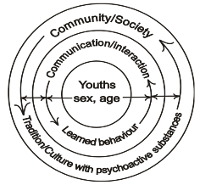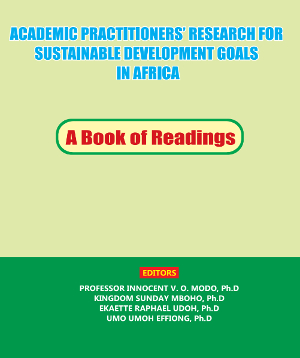SUBSTANCE ABUSE AND DEVIANT BEHAVIOURS AMONG IBIBIO YOUTHS: LATENT DYSFUNCTION OF SELECTED COMMUNITIES
Abstract
INTRODUCTION
Cultural values have the capacity to influence people‟s attitudes toward substance abuse and their risk of experimentation with psychoactive substances. Substance abuse is related to the cultural values of society. Abbott and Chase (2008) posit that socio-cultural beliefs can shape the approach to and behaviour regarding substance use and abuse. According to Soto et al. (2011), many studies show that traditional cultural values influence adolescents‟ attitudes and beliefs, which in turn influence their health risk behaviours (for example, cigarette, alcohol, and drug use) According to their report, there exists few studies which show how specific cultural values can be or operate as protection against substance use (Unger et al., 2002; 2006; Castro et al., 2007).
Heath (2001) is of the opinion that culture plays a central role in forming the expectations of individuals about potential problems they may face with drug use. Substance use and abuse is found to be rooted in culture of the people (Peters, 2019). According to Jiloha (2009), drug abuse is a complex phenomenon, which has various social, cultural, biological, geographical, historical and economic aspects. Jiloha further maintained that apart from cultural practices, the disintegration of the old joint family system, absence of parental love and care in modern families where both parents are working, decline of old religious and moral values etc lead to a rise in the number of adolescent drug addicts who take drugs to escape hard realities of life. According to Effiong and Agha (2020), early intervention strategies can mitigate psychosocial ill health. Some strategic interventions include social intervention, psychosocial intervention, medical intervention, advocacy, and community-based rehabilitation.
Downloads
References
Abbott, P. and Chase, D. M. (2008). Culture and Substance Abuse: Impact of Culture Affects Approach to Treatment. Retrieved online on 13th May, 2023.
Alan, I. L. (2003). Drug abuse and prevention. Washington D.C: National Institute on Drug Abuse.Wadswoth. 102p
Bridges, G.S. and Scott A. D. (2000). Deviance Theories. In Edgar E. B. and Rhonda J. V. M (Eds.) Encyclopedia of Sociology. Second Edition. Vol.1. USA: Macmillan.
Castro, F. G., Garfinkle, J., Naranjo, D., Rollins, M., Brook, J. S, and Brook, D. W. (2007). Cultural traditions as “protective factors” among Latino children of illicit drug users. Substance Use and Misuse,42(4):621–642.
Efik People. “Britannica". www.britannica.com. Retrieved on 13th May, 2023.
Effiong, U. U. and Agha, E. O. (2020). Rehabilitation Interventions and Non-Medical Use of Prescription among Persons with Psycho-Social Disabilities in Nigeria. Perspective on Drug, Alcohol and Society in Africa, 5(1), 92-108.
Fetterman, D. M. (2010). Ethnography: Step-by-Step. SAGE Publication, Inc. California. 42-50p.
Guerreroa, E. and Andrews, C. M. (2011). Cultural competence in outpatient substance abuse treatment: Measurement and relationship to wait time and retention. Journal of Drug and Alcohol Dependence. Retrieved from http://www.elsevier.com/locate/drugalcdep on 13th May, 2023.
Jiloha, R. C. (2009). Social and Cultural Aspects of Drug Abuse in Adolescents.Delhi Psychiatry Journal, 12 (2): 77 – 89.
Jiloha, R. C. (2009). Social and Cultural Aspects of Drug Abuse in Adolescents.Delhi Psychiatry Journal, 12 (2): 77 – 89.
McGovern, P. (2009). Uncorking the Past: The Quest for Wine, Beer, and Other Alcoholic Beverages. Berkley (CA). 71-95p.
Nwagu, E. N., Dibia, S. I. C. And Odo, A. N. (2017). Socio-cultural norms and roles in the use and abuse of alcohol among members of a rural community in Southeast Nigeria. Health Education Research, 32 (5): 423–436,
Nwaubani, A. T. (2013). Igbo burials: How Nigeria will bid farewell to Achebe. Retrieved online on 13th of January, 2019 from https://www.bbc.com/news/world-africa-22610497
Nzoiwu, A. (2012). A Sculptural Representation of „Traditional‟ Marriage (Igba Nkwu) in Ichida Town, Anambra State. Mgbakoigba: Journal of African Studies,1 (1): 53 – 67.
Peters, M. I. (2019). Cultural Practices Enhancing Drug Abuse Among Rural Youths in Etinan Local Government Area of Akwa Ibom State. Unpublished Masters Dissertation from Department of Sociology and Anthropology, University of Uyo, Uyo. 1-26p
Peters, M. I., Bassey, A. E., Usoro, N. A. and Samuel, M. E. (2022). Hymn No. 4: A Novel Psychoactive Substance Consumption among Ibibio Youths of the Niger Delta Region of Nigeria. International Journal of Educationand Science Development (IJESD) 1(2): 29-30 Available from:
https://www.researchgate.net/publication/370682669 [accessed May 21 2023].
Peters, M. I. and Bassey, A. E. (2020). Psychoactive Drug Use and Drug Abuse among Young People in Riverine Areas of Nigeria: A Spotlight on Selected Communities in Akwa Ibom State. Ripples of Culture: Journal of Anthropology. 1 (1): 62 - 72
Rock, P. (2013). Deviant Behaviour. Abingdon; Routledge.
Room, R. (2013). The Cultural Framing of Addiction. Centre for Social Research on Alcohol and Drugs. Trivium Publications, Pittsburgh, PA. 34 – 50p.
Šarić, J., Sakoman, S. & Zdunic, D (2002). Drug Abuse and Involvement in Criminal Behaviour. Drustvena istrazivanja: Journal for General Social Issues 11(2):353-377
Soto, C., Unger, J. B., Ritt-Olson, A., Soto, D. W., Black, D. S., and Baezconde-Garbanati, L., (2011). Cultural Values Associated With Substance Use Among Hispanic Adolescents in Southern California. Retrieved online https://www.ncbinim.nih.gov/articles on 17th May, 2023.
Unger, J. B., Ritt-Olson, A., Teran, L., Huang, T., Hoffman, B. R., and Palmer, P. (2002). Cultural values and substance use in a multiethnic sample of California adolescents. Addiction Research and Theory, 10(3):257–279.
Unger, J. B., Shakib, S., Gallaher, P., Ritt-Olson, A., Mouttapa, M., and Palmer, P. H. (2006). Cultural/interpersonal values and smoking in an ethnically diverse sample of Southern California adolescents. Journal of Cultural Diversity, 13(1):55–63. Heath, D. W. (2001). Cultures and
substance abuse. Psychiatrist Clinical Journal of North America,17 (24):479-496.
US Department of Justice (2023). Deviant Behaviour and Control. Retrieved from https://www.ojp.gov/ncjrs/virtual-library/abstracts/deviant-behavior-and-socialcontrol#:~:text=TO%20EXPLAIN%20THE%20PROCESSES%2C%20IMPACT,ILL%3B%20AND%205)%20SUICIDES.
World Health Organization (2014). Global Status Report on Alcohol and Health. 2014. Retrieved from http://www.who.int/substance_abuse/pdf. Retrieved on 13th May, 2023.

Downloads
Published
Issue
Section
Categories
License
Copyright (c) 2024 AKSU Annals of Sustainable Development

This work is licensed under a Creative Commons Attribution-NonCommercial-NoDerivatives 4.0 International License.
Manuscript content on this site is licensed under Creative Commons Licenses. Authors wishing to include figures, tables, or text passages that have already been published elsewhere are required to obtain permission from the copyright owner(s) for both the print and online format and to include evidence that such permission has been granted when submitting their papers. Any material received without such evidence will be assumed to originate from the authors.





 ICIDR Publishing House
ICIDR Publishing House